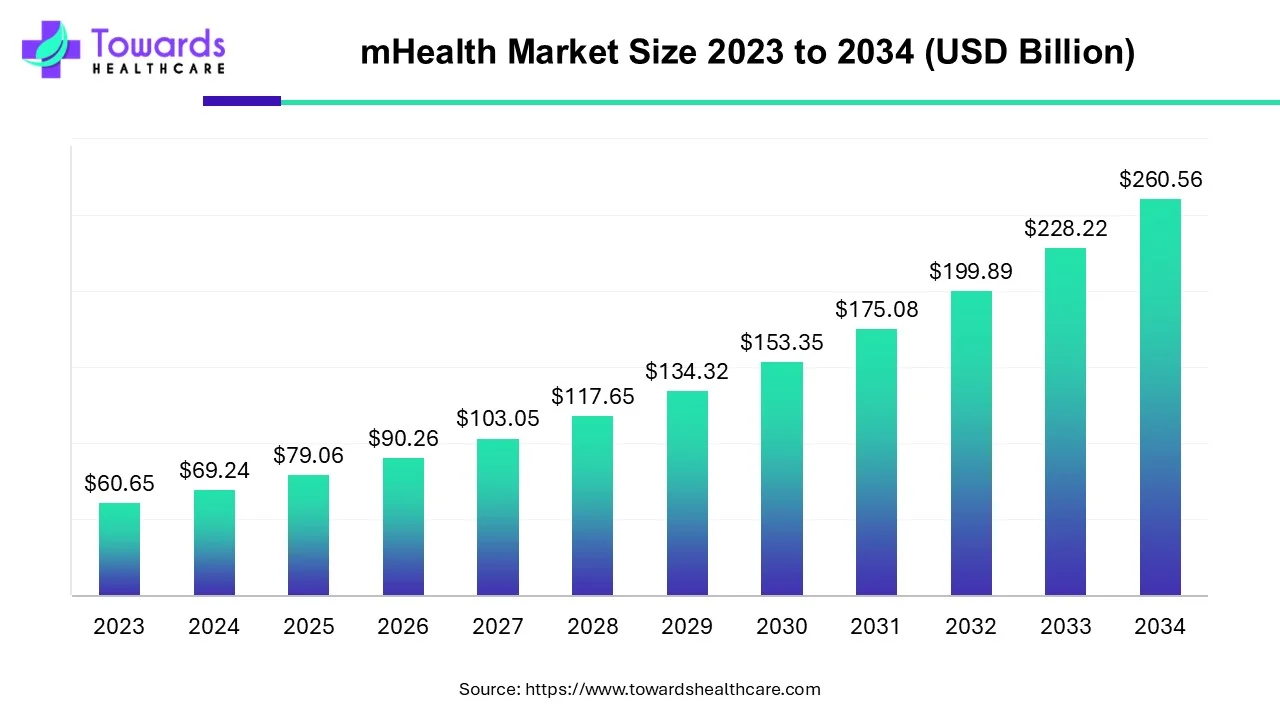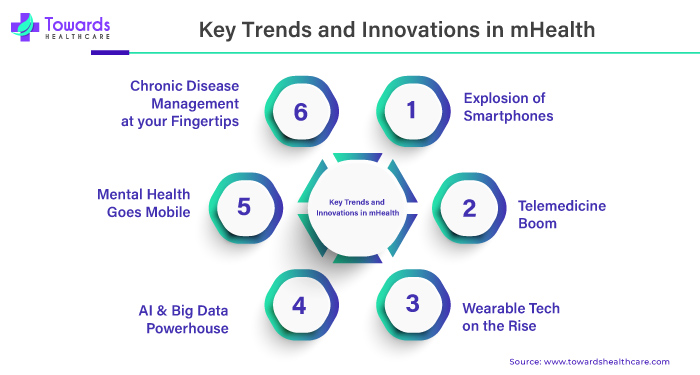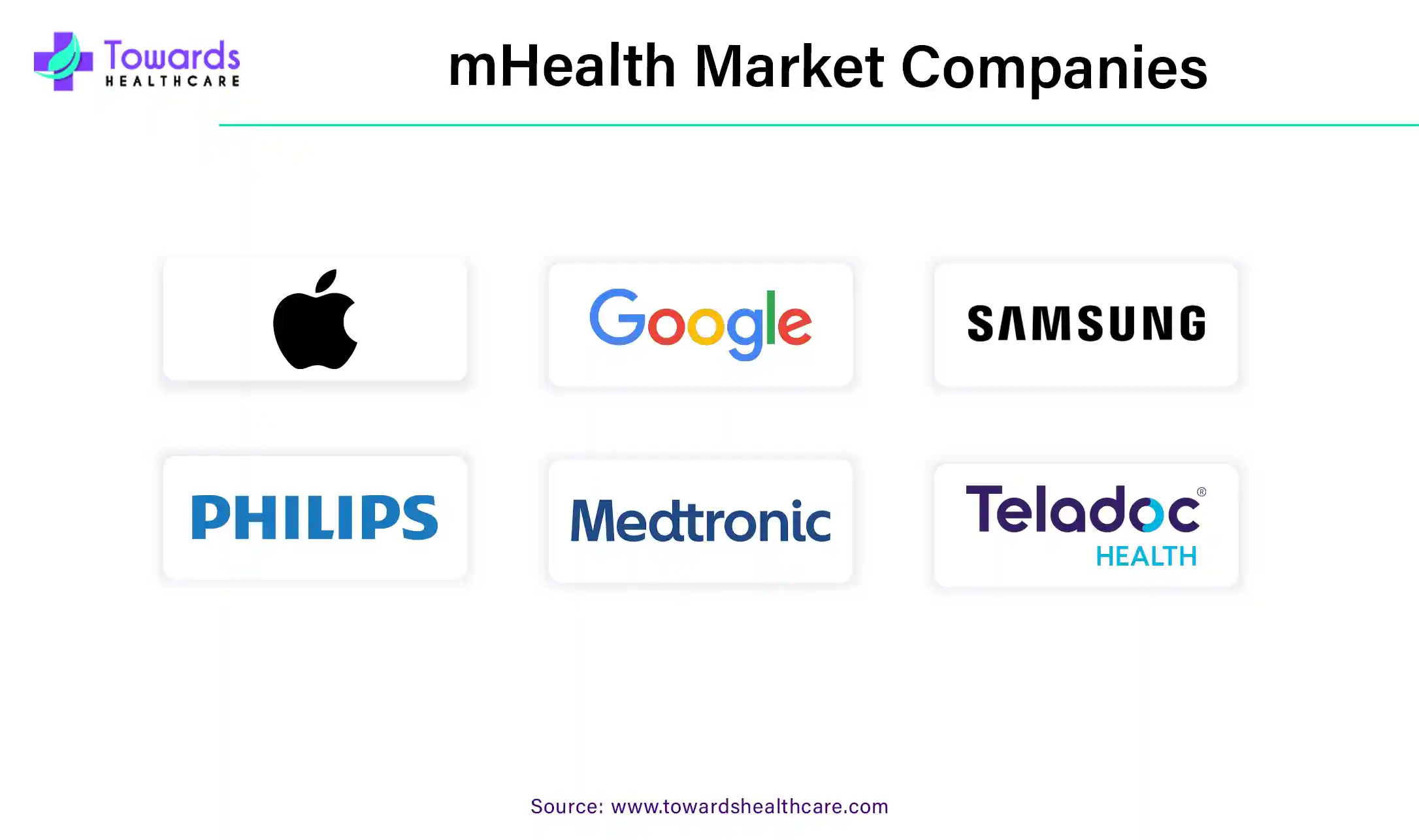March 2025

.webp)
Principal Consultant

Reviewed By
The mHealth market size is forecast to grow from USD 79.06 billion in 2025 to USD 260.56 billion by 2034, driven by a CAGR of 14.17% from 2025 to 2034.

Healthcare providers are getting more interested and excited about mobile health (mHealth) apps, with over a third of doctors suggesting them to patients. When doctors suggest these apps, people tend to keep using them for about 30 days more than usual, with a 10% higher retention rate for health apps and 30% higher for fitness apps.
mHealth revolutionizes healthcare by utilizing mobile devices and health-related apps to enhance service delivery, monitoring, and management. The significance of mHealth in society becomes evident through its multifaceted benefits. First and foremost, it addresses the issue of accessibility, allowing individuals, particularly those in remote areas, to access health information and services regardless of geographical constraints. Additionally, mobile apps empower users to actively monitor their health, from tracking fitness levels to managing chronic conditions and receiving timely medication reminders. The advent of telemedicine through mHealth facilitates remote consultations with healthcare professionals, proving invaluable for routine check-ups.

A recent Newsletter from the World Health Organization
Beyond individual empowerment, mHealth serves as a powerful tool for health education. Mobile apps serve as platforms for disseminating information, promoting awareness, and educating communities about healthy lifestyle choices. This proactive approach aids in disease prevention and contributes to overall community well-being. Additionally, mHealth plays a pivotal role in data collection and analytics, aggregating health data from various sources. This data-driven approach provides valuable insights for healthcare providers and policymakers, enabling the identification of health trends and formulating effective public health strategies.
The escalating global demand for mHealth can be attributed to several factors. The widespread adoption of smartphones globally expands the potential user base for mHealth applications, fostering increased demand. The COVID-19 pandemic underscored the importance of remote healthcare solutions, positioning mHealth as a critical tool for maintaining healthcare services while minimizing physical contact. The inherent convenience and efficiency of mHealth, reducing the necessity for physical visits to healthcare facilities, appeal to consumers and healthcare providers. With a rising prevalence of chronic diseases worldwide, mHealth emerges as a solution for continuously monitoring and managing these conditions, further fueling demand. Furthermore, government initiatives promoting digital health play a pivotal role in encouraging the development and widespread adoption of mHealth solutions, solidifying its position as a transformative force in global healthcare. In essence, mHealth simplifies healthcare management through smartphones, gaining international recognition for its convenience, health monitoring capabilities, and facilitation of remote healthcare services.
The surge in smartphone adoption stands as a cornerstone in propelling the expansion of the mHealth market. This phenomenon is marked by the widespread ownership and utilization of smartphones globally. The significance of this trend is underpinned by various factors that underscore the transformative impact of increased smartphone adoption in the realm of mHealth.
For Instance,
Additionally, smartphones have evolved into ubiquitous devices, transcending diverse demographics and geographical locations. The ubiquity of smartphones ensures that a substantial portion of the global population possesses these devices, establishing a broad and varied user base for mHealth applications.
| Device Details | Launch Date | Features |
| Apple Watch Series 8 | September 16, 2023 |
|
| Livongo Health Partnership with UnitedHealthcare | November 15, 2023 |
|
| Babylon Health Symptom Checker App | November 21, 2023 |
|
| Fitbit Sense 2 | October 27, 2023 |
|
| Omada Health FDA Clearance for Insomnia Therapy | December 22, 2023 |
|
The growing popularity of smartphones also hinges on user familiarity, as individuals across different age groups and technological backgrounds increasingly integrate these devices into their daily lives. The user-friendly interfaces and intuitive nature of smartphones make them accessible to a broad audience, including those who may not be technologically savvy. A key attribute contributing to the synergy between smartphones and mHealth is the 24/7 connectivity they afford. Smartphones give users constant access to information and services, a precious feature in mHealth. This continuous connectivity facilitates timely access to health information, monitoring tools, and virtual consultations, enhancing the overall effectiveness of healthcare services.
The app ecosystem embedded in smartphones plays a pivotal role by seamlessly integrating mHealth applications into users' daily routines. The ease with which individuals can download, install, and use health-related apps promotes user engagement and fosters adherence to health management practices. Beyond communication, smartphones exhibit multifunctional capabilities, boasting features such as cameras, sensors, and GPS. These applications can harness mHealth attributes for various functionalities, including monitoring physical activity, capturing health data, and tracking location-based health trends. Smartphone adoption is inclusive, cutting across different demographics such as age groups, socioeconomic backgrounds, and educational levels. This inclusivity ensures that mHealth solutions can be designed to cater to a diverse range of users, contributing to the equitable provision of healthcare services.
The global penetration of smartphones in developed and developing countries further amplifies the impact of mHealth solutions. This widespread presence enables mHealth applications to transcend geographical and economic barriers, influencing healthcare delivery and access on a global scale. The personalization capabilities inherent in smartphones play a vital role in mHealth applications. Advancement in health-related information, reminders, and interventions to individual user preferences and health needs enhances user engagement and fosters adherence to health management plans.
For Instance,
Continuous technological advancements in smartphones, encompassing improved processing power, enhanced sensors, and better connectivity options, contribute to the sophistication and capabilities of mHealth applications. This evolution enables developing more advanced and effective health monitoring and management tools. The increased adoption of smartphones globally stands as a foundational pillar for the growth of the mHealth market. The ubiquity, accessibility, and multifunctionality of smartphones create an environment where mHealth applications can reach and positively impact a broad and diverse user base, ultimately contributing to improved healthcare delivery and outcomes.
Telemedicine delivers healthcare services through digital communication technologies, including consultations, diagnoses, and treatment plans. mHealth, with its emphasis on mobile devices and applications, plays a pivotal role in making Telemedicine accessible and user-friendly. Several vital aspects highlight the significance of Telemedicine within the context of mHealth.
For Instance,

Telemedicine has gained widespread adoption due to its unparalleled convenience, benefiting patients and healthcare providers. Enabled by mHealth platforms, individuals can easily connect with healthcare professionals from their homes, eliminating the need for physical travel to medical facilities. This accessibility is particularly significant for remote or underserved areas with limited healthcare resources. The COVID-19 pandemic accelerated the embrace of telemedicine as social distancing measures and lockdowns necessitated alternative healthcare delivery methods. Virtual consultations quickly emerged as a safer and viable option, with mHealth technologies playing a pivotal role in ensuring remote healthcare access and minimizing the risk of virus transmission. Beyond convenience, telemedicine, powered by mHealth, eases the burden on healthcare facilities by providing an alternative to in-person visits for non-emergent medical concerns. This streamlines healthcare services and optimizes resource allocation, allowing medical professionals to focus on critical cases.
Virtual consultations through mHealth platforms prove invaluable for follow-up appointments and routine check-ups, especially for patients with chronic conditions. This approach enables ongoing care and monitoring without frequent visits to healthcare facilities, contributing to improved healthcare management. The integration of mHealth technologies with telemedicine platforms enhances the overall user experience. Mobile apps facilitate various aspects, including appointment scheduling, secure video calls, electronic health record access, and medication reminders.
For Instance,
The surge in telemedicine adoption, driven by mHealth technologies, represents a transformative shift in healthcare delivery. The convenience, accessibility, and efficiency of virtual consultations, especially accentuated by the demands of the COVID-19 pandemic, have positioned telemedicine as an integral component of modern healthcare, facilitated by the capabilities of mHealth applications and mobile devices.
The challenge of unequal access to technology presents formidable constraints on the growth and impact of mHealth initiatives. This digital divide manifests through disparities in accessing smartphones, internet connectivity, and digital literacy, creating barriers that impede the inclusivity and effectiveness of mHealth services. Vulnerable populations in rural areas, low-income communities, and developing regions need help obtaining smartphones or accessing stable internet connections, hindering their full participation in mHealth services and limiting market reach. The unequal distribution of technology access exacerbates existing health inequalities, particularly among demographic groups with lower socioeconomic status or limited educational attainment, potentially excluding them from health-promoting interventions and essential healthcare services provided through mHealth tools.
This, in turn, leads to reduced adoption rates among specific demographic segments, impeding overall market growth potential. Due to the digital divide, the underrepresentation of particular demographics in mHealth data sets affects the accuracy and generalizability of health insights derived from analytics, potentially overlooking vital information about specific populations' health status and needs. In scenarios involving remote monitoring or follow-up care, the digital divide disrupts the continuity of care, as patients who need access to smartphones or reliable internet face challenges participating in virtual consultations or receiving timely follow-up support. The resulting inequitable health outcomes underscore the importance of addressing this divide.
Additionally, the impact of mHealth initiatives relies heavily on users' digital literacy. Unequal access to technology results in varying levels of digital literacy among different demographic groups, affecting their ability to navigate and derive benefits from mHealth applications and limiting the impact of health education efforts. For individuals with chronic conditions, the digital divide becomes a barrier to effective disease management, impeding access to continuous monitoring through mHealth and potentially exacerbating health issues, thereby increasing long-term healthcare costs. Addressing the digital divide necessitates collaborative efforts from various stakeholders, including governments, private sector entities, and non-profit organizations. Initiatives focused on improving digital infrastructure, providing affordable smartphone access, and enhancing digital literacy are crucial to bridging the gap, ensuring that mHealth services reach and benefit all population segments, and fostering a more inclusive and impactful market.
The geographical landscape of the mHealth market in North America reflects a dynamic and evolving ecosystem driven by technological advancements, regulatory frameworks, and healthcare infrastructure. North America primarily comprises the United States and Canada and is a significant player in the global mHealth market. The market has been experiencing growth due to the increased adoption of mobile devices, a supportive regulatory environment, and a focus on telemedicine.

High smartphone penetration rates and widespread use of mobile applications contribute to the growth of the mHealth market. Wearable devices, fitness trackers, and other connected health technologies are becoming increasingly popular among consumers, driving innovation in the health sector. Government initiatives and policies play a crucial role in shaping the mHealth landscape. For example, the Centers for Medicare & Medicaid Services (CMS) has implemented various programs and policies to support telehealth services.
The mHealth market is booming in the Asia-Pacific region because many people live there, more folks are using smartphones, and they're becoming more aware of digital health solutions. Countries like China, India, South Korea, and Japan are seeing a significant increase in smartphone and internet use. This is creating a solid base for the growth of mobile health solutions. New startup communities in places like India and Singapore focus on digital health. These startups are making excellent mHealth solutions, like apps to watch your health and platforms for online doctor visits.
The mHealth market's competitive landscape is shaped by ongoing innovations, partnerships, and technological advancements. The convergence of healthcare, technology, and consumer demand continues to drive competition and opportunities for players across various segments of the mHealth ecosystem. Regional players and collaborations between technology providers, healthcare organizations, and startups contribute to the diverse and expanding mHealth ecosystem. Telemedicine startups like Doctor on Demand provide virtual healthcare services, including consultations with healthcare professionals.

By Offerings
By Application
By End User
By Geography
March 2025
March 2025
March 2025
March 2025